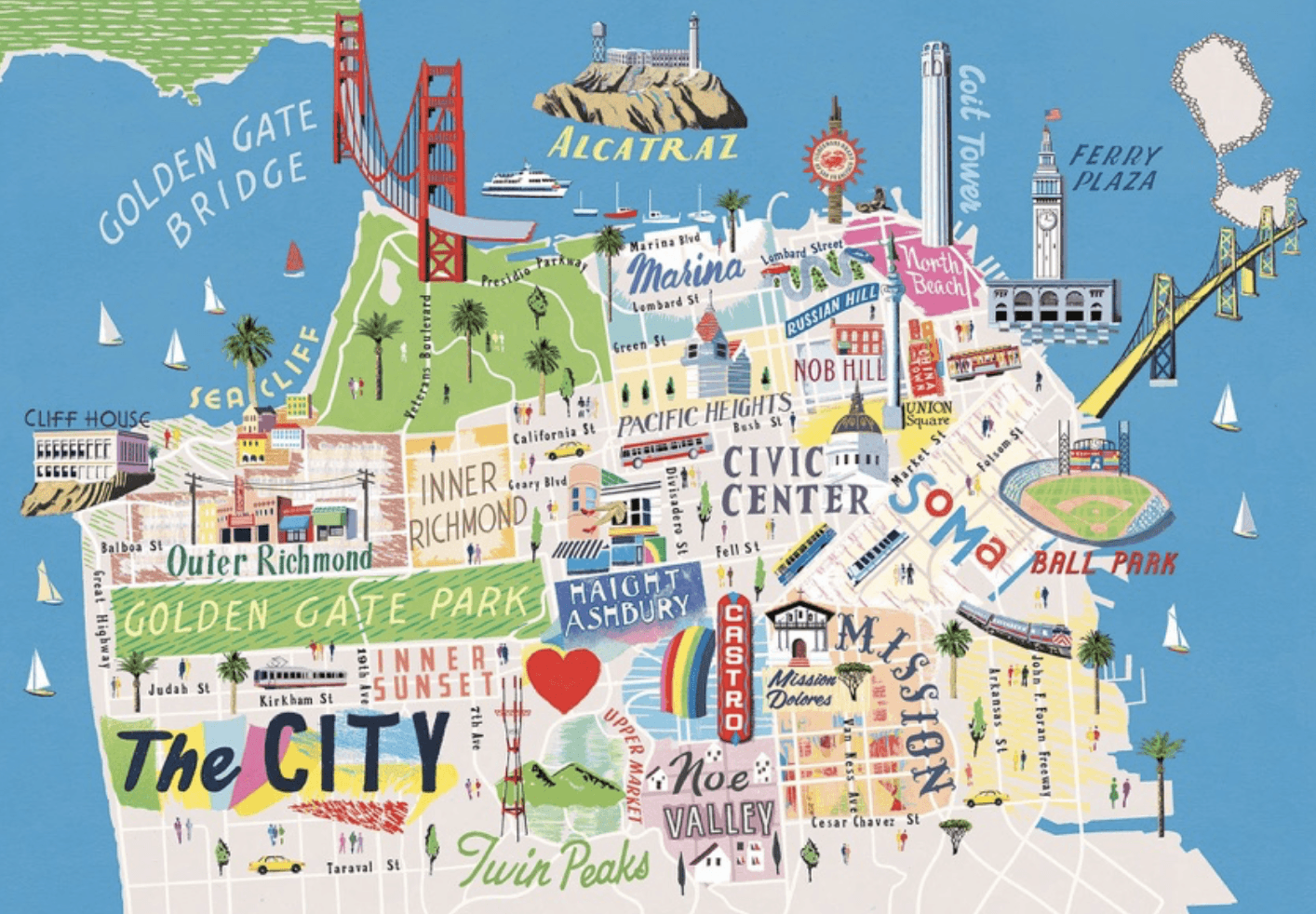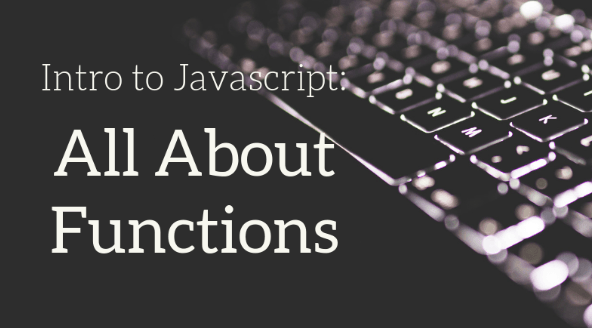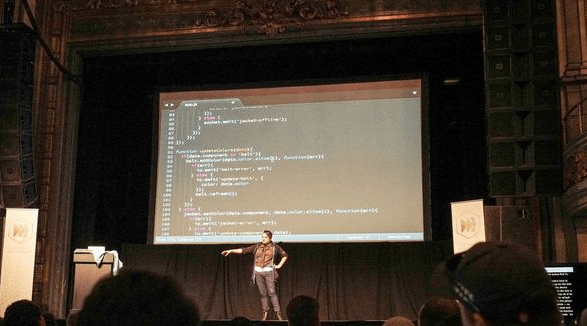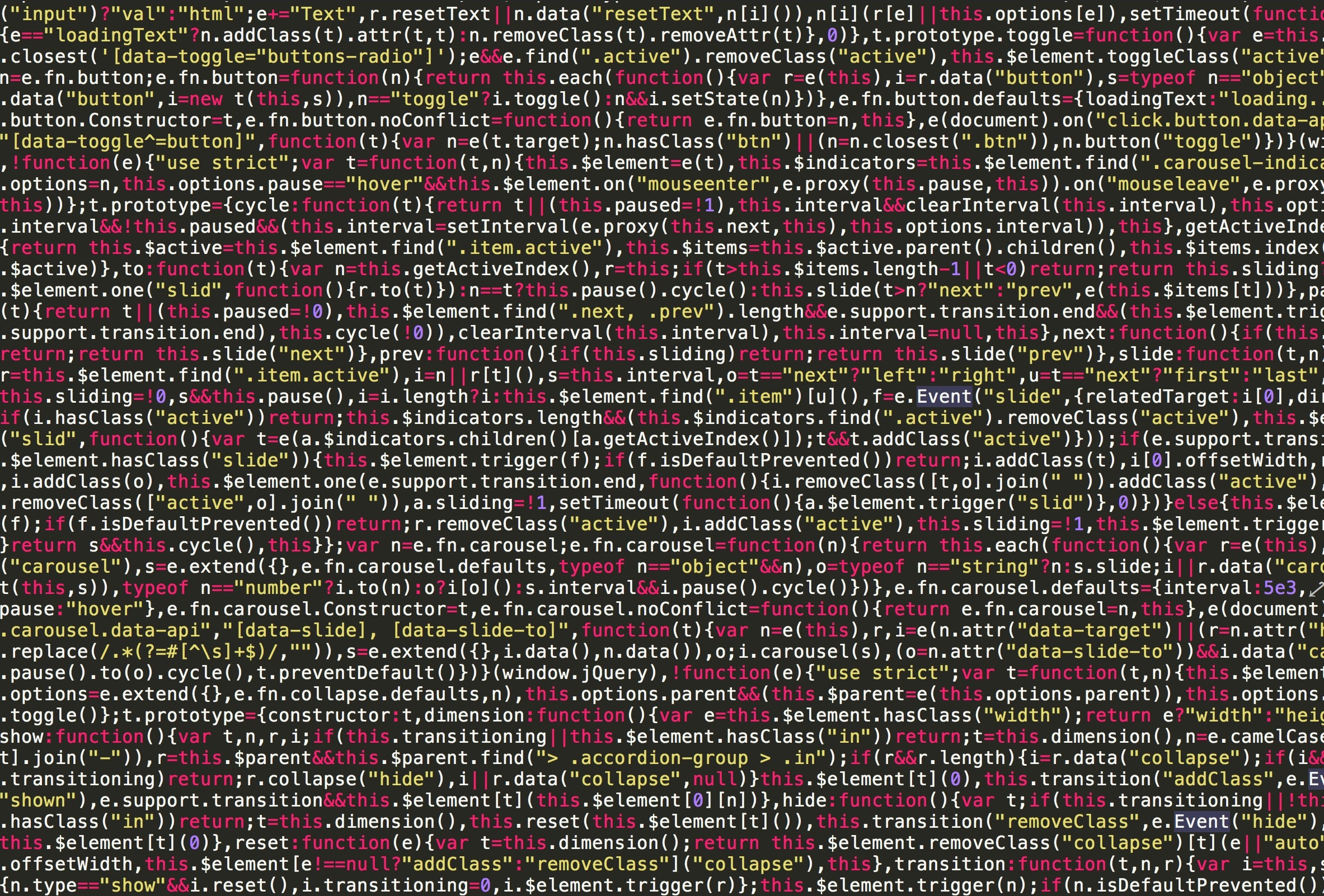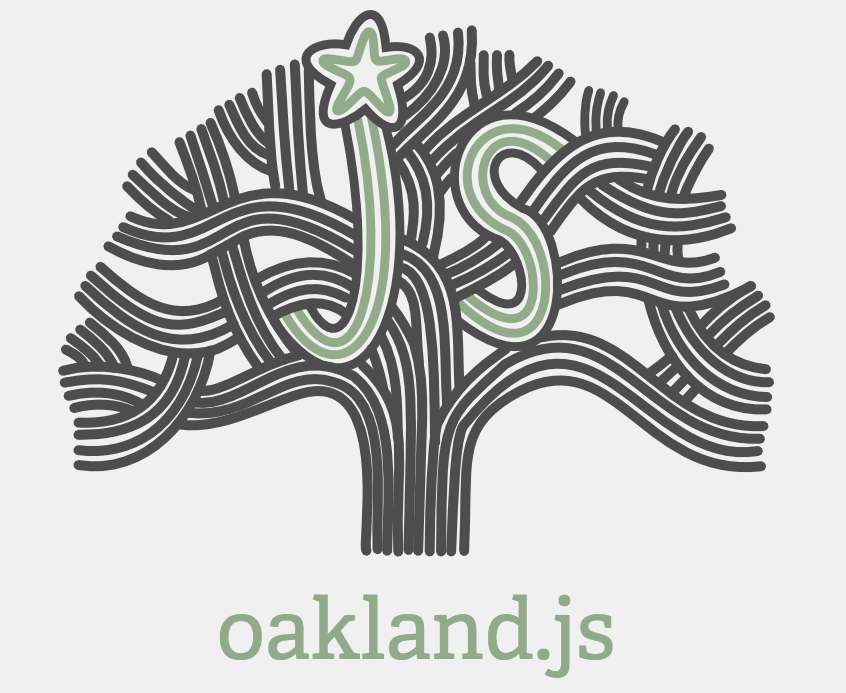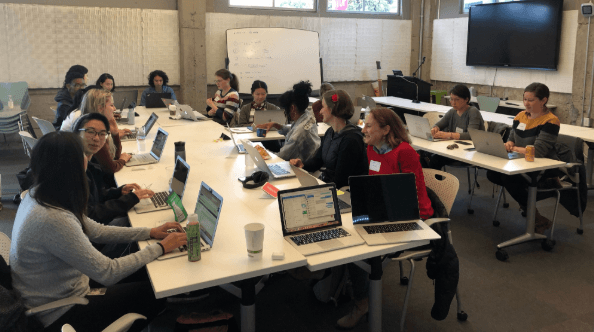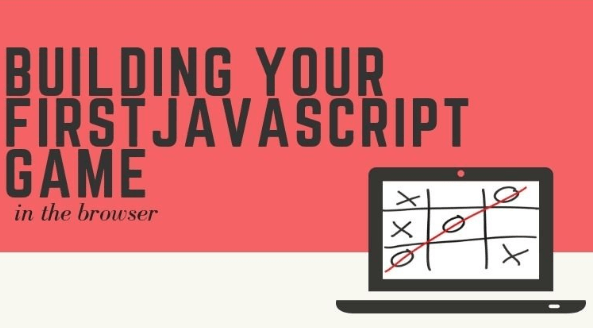How to Live and Work Well in San Francisco
So you want to land your dream job in San Francisco with the perfect company. But it’s in a region home to some of the United States’ most expensive cities. Add to that the horror stories of working grueling hours to churn out the latest in tech innovation. Suddenly, you’re left questioning if that dream job is worth all the time and money.

It’s true that San Francisco boasts an eclectic union of innovative companies and bustling urban scene. As a result, the city is an exciting melting pot of technology, history and diversity. But it’s also full of fast-paced, high profile companies and chaotic startups alike. Because of that, developers might think it’s impossible to actually work and live well in this city. However, with some thoughtful planning and budgeting, San Francisco developers can enjoy (and afford!) a healthy work/life balance.
As a tech recruiting agency, Elevano places countless developers throughout San Francisco every year (we’re always looking to place more)! So we know a thing or two about how developers manage a great work/life balance without breaking the bank. Lucky for you, we want to share that information. Read on for a complete guide on how to work and live well in San Francisco, including:
- The companies you could work for in San Francisco
- The cost of living (housing, commuting)
- The dining and entertainment experiences this region has to offer!
Why Move to San Francisco?
San Francisco, California is widely thought of as one of the country’s most desirable cities. The scenery is stunning, the weather is mild year-round, and it’s impressively multicultural.
So it doesn’t really come as a surprise that many people throughout the U.S (and the world!) want to live in San Francisco, especially if they’re looking for tech jobs.
The downside, of course, is that San Francisco is also one of the country’s most expensive cities to live in. Transportation, food, and housing all come at a significantly higher price tag than many other places in the United States. Today, remote work opportunities are growing. Add to that the rise of other tech hubs throughout the world, and it’s understandable why you would question the move to a city as expensive as San Francisco.
While it’s not necessary to be in San Francisco to have a successful career as a developer– or any other job in tech– it certainly does have its benefits. It’s just like how budding filmmakers head to Los Angeles or financial traders flock to New York City.
San Francisco’s strong community of like-minded professionals appeals to developers, at every stage in their career. For ambitious developers in the early stages of their career, a move to San Francisco is especially worthwhile. Learning compounds. The more skills you learn early on, the better things will work out for you in your tech career.
Map of San Francisco – Neighborhoods and Attractions
Finding Work
It all starts with finding your dream job. Lucky for you, San Francisco is home to multinational companies and blossoming startups alike.
If you have the skills and experience behind you, you can be selective when it comes to industry, company size and culture. After all, it’s your first step to achieving a good work/life balance. Which companies offer competitive PTO? Team events? Work-from-home days or flexible schedules? More than you might think! Here are our top picks!
Companies in San Francisco: High Profile
1. Adobe
Generous does not even begin to describe the perks and benefits packages at Adobe. From educational grants to commuter packages, this company is providing its employees with a bevy of perks that can seriously make a difference in retaining top talent.
Annual Revenue: $9B
Employees: 21,357
Adobe hires software engineers and developers for product development and management, cloud technology, research labs, and information technology
Employee Benefits –
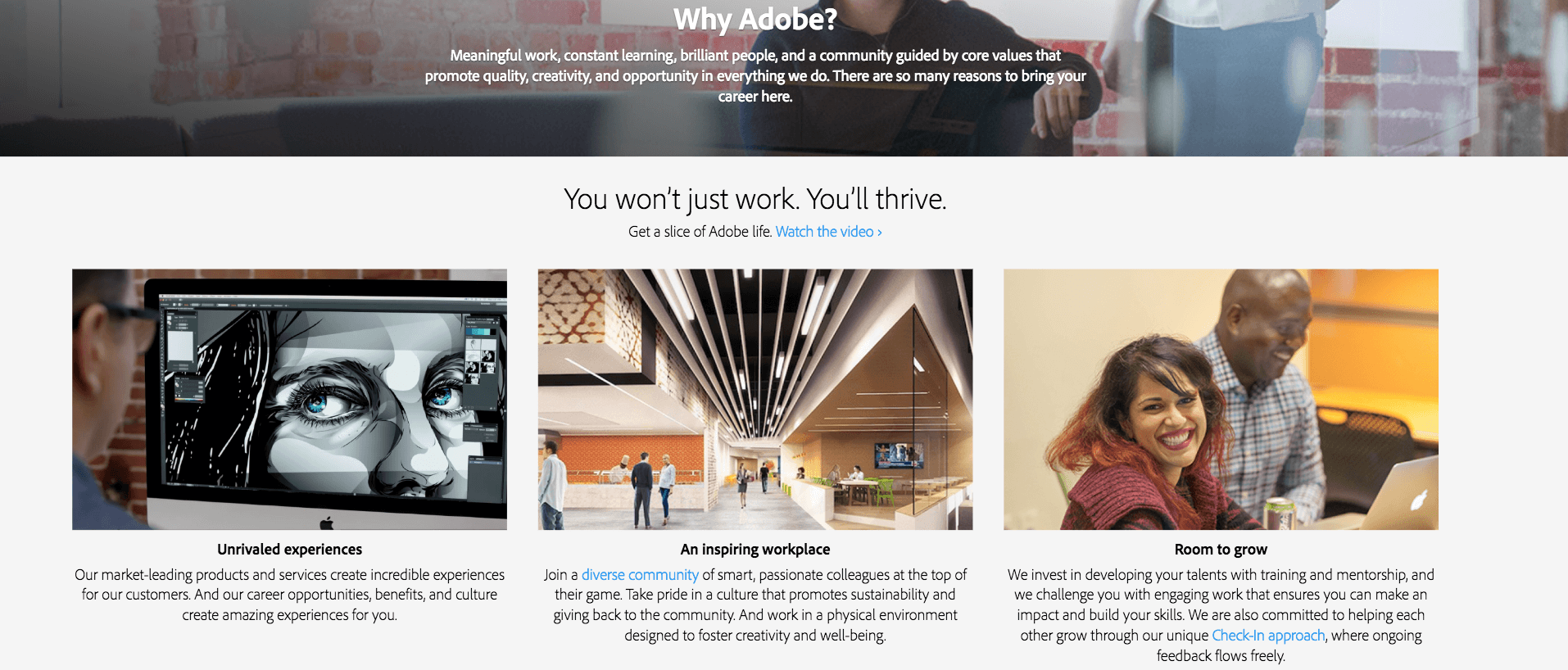
Education: Adobe offers employees $10,000 per year “for tuition and books for courses, certificate programs and graduate programs that meet the program’s eligibility criteria.” The company also allows employees to set aside pre-tax savings for their children’s college education, as well as access to a college admissions and financial aid officers to make the process a little easier on their employees.
Family Care: Adobe allows employees to set aside up to $5,000 pre-tax per year for child day care expenses or elder care. The company will even chip in up to $1,200 per year to assist with child care expenses for children up to 13 years old.
Social Good: Adobe will match any and all donations and volunteer time up to $10,000 per year.
2. Airbnb
As one of the most successful companies in the world right now, it may not come as a surprise that Airbnb offers some amazing perks and benefits for its employees. Yes, free snacks and flexible schedules are part of it, but there is much more.
Annual Revenue: $2.8B
Employees: 4,000
Airbnb hires developers for a wide variety of jobs, including software engineers, salesforce developers, engineering management, backend software engineers, iOS and Android software engineers, data architects, project managers, and several others.
Employee Benefits-
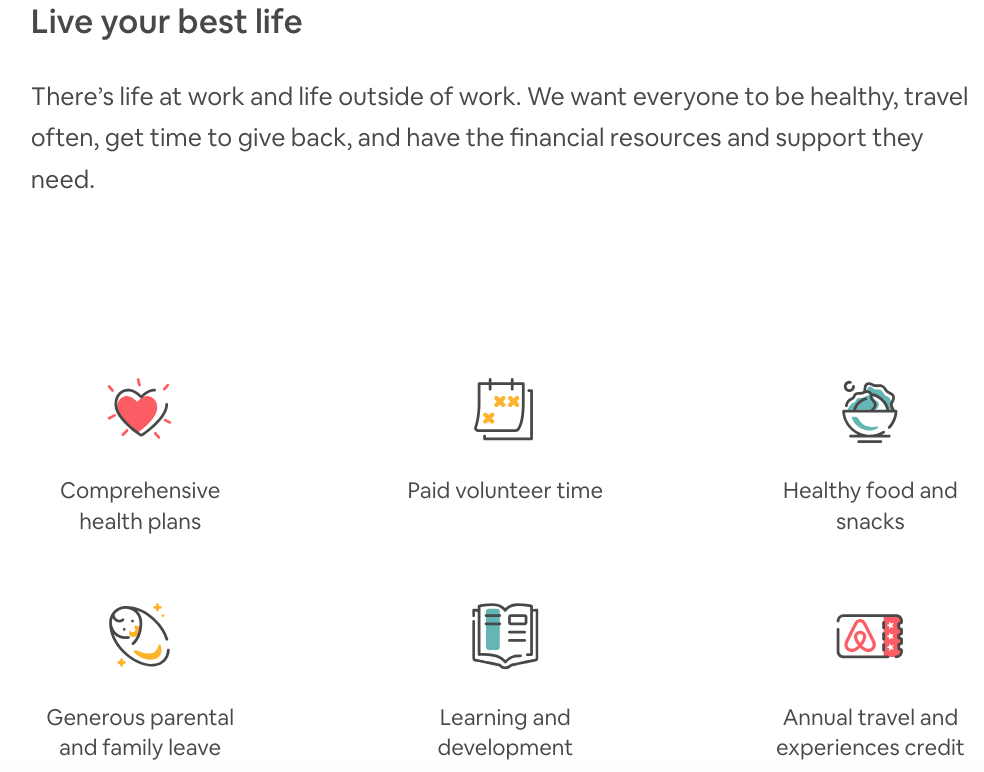
Time Off: Airbnb employees are given the flexible option to work from home when necessary, a full two weeks vacation during the holiday months (in addition to other paid vacation days and annual travel credits), and 10 weeks of paternity leave and even more for maternity leave.
Health Benefits: Airbnb provides incredible comprehensive packages for health, vision, dental, and everything in between with no out of pocket expenses for employees, and only 25 percent for dependents.
Volunteering: Airbnb provides their employees with paid volunteer time to get out and make a difference in their community.
3. Cisco
When you’re one of the biggest companies in the Bay Area, spending on your employees kind of comes with the deal. Fortunately, Cisco does not disappoint.
Annual Revenue: $50.8B
Employees: 74,200
Cisco hires engineers and developers in the software, hardware, network, and product management fields.
Employee Benefits-

Social Events: At Cisco, each department is given its own budget to do with it what they please, whether they choose to go out to a bar or do battle at the local laser tag arena.
Birthdays: Cisco wants to make sure you’re celebrating your birthday right, which means you get a full day off. Never work on your birthday again, the way it was meant to be.
Support: A little positive reinforcement goes a long way, which is why Cisco has a dedicated recognition platform that allows employees to call out others for going above and beyond for the company. And they come with prizes!
4. Facebook
As one of the biggest companies in the world, Facebook is able to offer its employees some amazing perks and benefits.
Annual Revenue: $55.8B
Employees: 35,587
Facebook hires developers and engineers in design and user experience, augmented and virtual reality, infrastructure, product management, security, and software.
Employee Benefits-
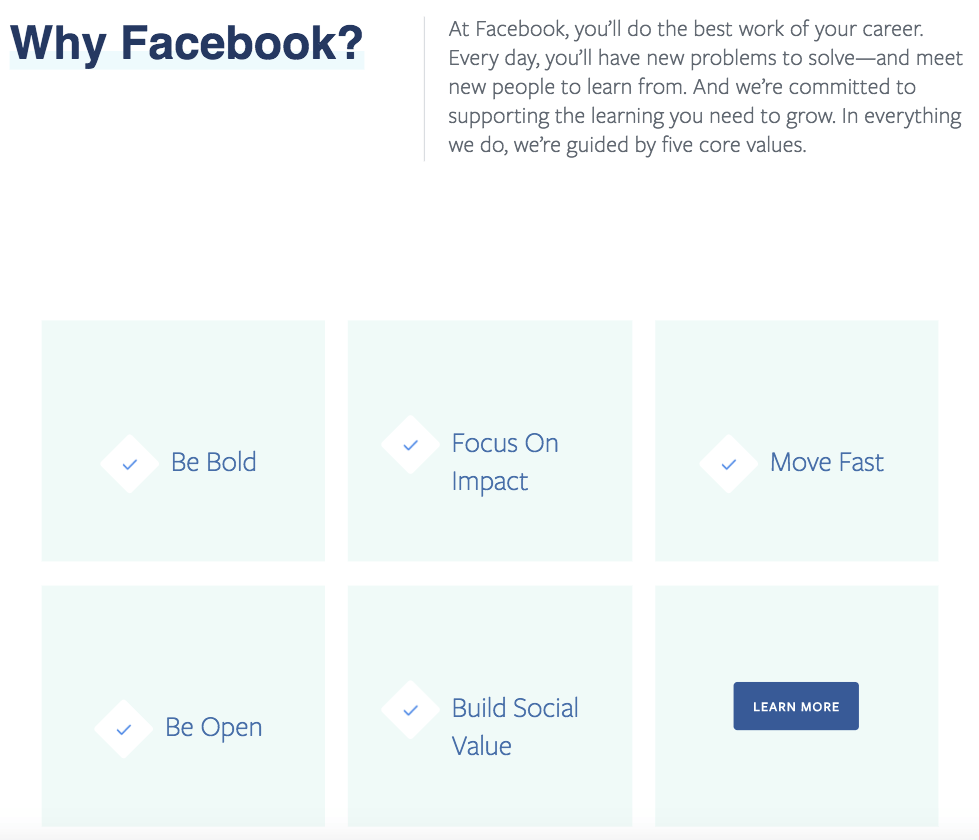
Family Planning: Facebook provides four months of parental leave for mothers and fathers within the first year of the birth or adoption. The company also provides up to $4,000 in “baby cash” for new parents.
Vacation: At Facebook, employees get three weeks of paid vacation per year.
Paradise of Perks: The company’s headquarters in Menlo Park is a paradise of perks, from a barbershop and full arcade to dry cleaning and valet parking.
Companies in San Francisco: Startups or Pre-IPO Companies
With almost 40,000 startups in San Francisco, there’s bound to be a company that checks all your job search boxes! Here are a two up and coming companies that you might already know:
1. Slack
Slack is a communication platform that brings businesses and teams together. The company’s mission is to help connect people with the apps, services, and resources they need to get things done.
Slack hires backend developers, software engineers, engineering managers, iOS and Android developers, UX developers, site reliability engineers, and several others.
Employee Benefits-
Slack prides itself on culture and making sure their employees have everything they need to do their best work. Benefits include parental leave, game nights, personal and professional development stipends, full health coverage at no cost to employees, fitness reimbursement, and Thursday socials
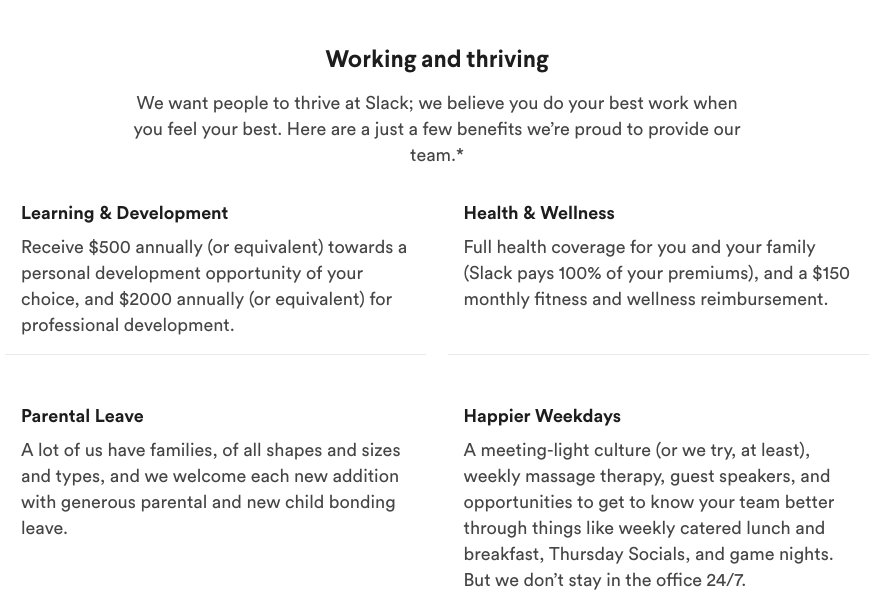
2. Lyft
According to LinkedIn, Lyft now controls 35 percent of the U.S. ride-sharing market.
Lyft hires data and infrastructure engineers, front end engineers, full stack engineers, software engineers, and security engineers among others.
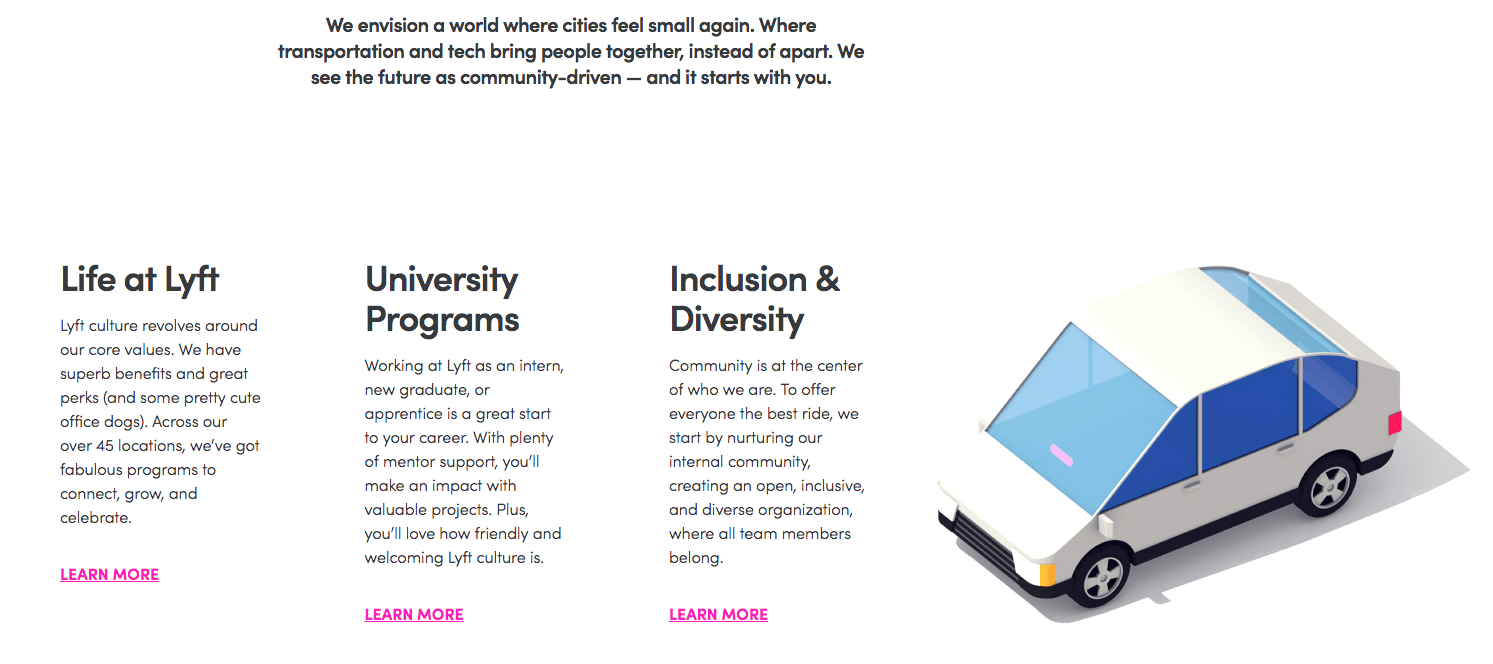 Employee Benefits-
Employee Benefits-
Lyft offers a wide range of employee benefits, including great medical, dental, and vision insurance options, office snacks, unlimited paid vacation for salaried employees, ride discounts, Udemy subscription, generous parental leave, social events, and dog-friendly offices.
Cost of Living
So you’ve landed your dream job. Now it’s time to get thinking about where you’re going to live and how you’re going to get to work. Could you partially offset housing costs by saving gas with a shorter commute? Can you find a more affordable housing option further out from your work? While it’s a tricky balance, there are accessible living options for developers at every salary range (even junior developers!) Here’s some more information on how to set and stick to a budget when it comes to renting or buying in San Francisco:
Housing
The city of San Francisco, and the Bay Area in general, has one of the highest living costs in the United States. As a result, affordable housing is hard to find, but it’s not impossible. Subsequently, it’s important to choose the right neighborhood. There are several, high-profile and startups located within a short commuting distance from San Francisco’s most popular neighborhoods. Amongst the companies mentioned above, Airbnb, Slack and Lyft all offer shorter commutes for people living in San Francisco itself. Larger companies including Facebook, Cisco and Adobe, for example, are further out from San Francisco’s CBD, and require commutes often ranging between 45 minutes – 1 hour.
Top San Francisco Districts: Median Rental and Home Purchase Costs
Inner Sunset
Median one-bedroom rent: $2,750/month
Median Home Value: $1,007,320
Outer Richmond
Median one-bedroom rent: $2,800/month
Median Home Value: $1,024,713
Presidio Heights
Median one-bedroom rent: $2,850/month
Median Home Value: $1,506,982
Russian Hill
Median one-bedroom rent: $3,740/month
Median Home Value: $1,025,593
Bernal Heights
Median one-bedroom rent: $2,810/month
Median home value: $1,534,900
The Mission
Median one-bedroom rent: $3,450/month
Median home value: $1,491,700
Nob Hill
Median one-bedroom rent: $3,110/month
Median home value: $1,469,300
Noe Valley
Median one-bedroom rent: $3,250/month
Median Home Value: $1,219,727
Most Affordable San Francisco Neighborhoods (Under $2850/ month)
If most of the above neighborhoods don’t make financial sense for you, don’t worry! In a city as costly to live in as San Francisco, it’s important to find and stick to a housing budget. Often in San Francisco (and throughout the Bay Area), that therefore means renting instead of buying. Fortunately, San Francisco has several neighborhoods that won’t break the bank– allowing you to budget enough to fund the life part of your work/life balance. Here are the median rental costs for affordable, one-bedroom apartments in San Francisco:

Bayview: $2,100/month
Bernal Heights: $2,810/month
Excelsior: $1,950/month
Glen Park: $2,800/month
Inner Sunset: $2,750/month
Outer Richmond: $2,800/month
Outer Sunset: $2,500/month
The Tenderloin: $2,190/month
How to Save on Housing Costs
- Make sure your rent or mortgage fits within your budget. It might be an obvious one, but the high cost of living in San Francisco takes a massive chunk out of your budget for monthly expenses. You therefore need to know what you can afford, and choose accordingly. It’s difficult to maintain a healthy work/life balance when you’re struggling to make your rent or mortgage payments!
- Find a roommate. If you’re moving to San Francisco on your own, finding a roommate (whether it’s for an apartment or the whole house) is a sensible way to save money on housing costs. There are several sites that can help you find an ideal roommate. For example, Easyroommate, For Rent, Roommates, and Kangaroom.
- Try to negotiate your rent. While it’s unlikely that this will work with apartments, it’s still possible to negotiate your rent down to something more affordable, particularly with renting a house.
- Move during the winter. Winter is often considered the “off-season” when it comes to moving and you can sometimes find better deal on rent.
- Look for a place outside of the city. Urban living is expensive in most cities. But the Bay Area offers a variety of places to live that are just a short distance to San Francisco. Take a look at Palo Alto, San Mateo, Redwood City, or San Jose, for example. This is especially true if you’re looking to work for giants such as Facebook, Cisco, Google, or Adobe.
Commuting
If you’re able to find housing in San Francisco that meets your budget, you need a way to get around. While you can drive, it might be a better option to use public transportation. Not having a car can save you money between the costs for gas, parking, insurance, taxes and other fees that come with car ownership!
Fortunately, San Francisco has an excellent public transportation system. It provides bus, cablecar, and rail services throughout the city. You can purchase a monthly pass for the cablecar, train and bus networks for about $70. Alternatively, depending on where you live, you might be able to cycle or walk to work.
Example Commutes
Every commute is different. Whether you travel by car, public transport, foot or otherwise, the associated distance and costs involved in getting to and from work are subjective. However, it’s useful to see what your commute could look like. Two of San Francisco’s most popular residential neighborhoods (as mentioned above) are Inner Sunset [Median Home Value: $1,007,320] and The Mission [$1,491,700]. Here are some commutes from these two districts, for example:
Commute to Slack:
From Inner Sunset – 24 minutes by car or 36 minutes by Muni Metro Rail
From The Mission – 14 minutes by car or 26 minutes by bus or BART
Commute to Nurx:
From Inner Sunset – 17 minutes by car or 29 minutes by Muni Metro Rail
From The Mission – 9 minutes by car, 19 minutes by BART, or 31 minute walk
Commute to Airbnb:
From Inner Sunset – 18 minutes by car or 40 minutes by Muni Metro Rail
From The Mission – 6 minutes by car, 26 minutes by bus, or 24 minute walk
Commute to Salesforce:
From Inner Sunset – 26 minutes by car or 32 minutes by Muni Metro Rail
From The Mission – 16 minutes by car, 20 minutes by BART
The Fun Stuff
So you’ve got the job. You’ve found somewhere to live. You’ve perfected your commute. Now it’s time for the fun stuff! Here’s the ‘life’ part of that work/life balance, and lucky for you, there’s no shortage of things to do, see and eat in San Francisco.
Dining
For coders spending their days working on projects that are going to change our world for the better: you deserve good food. So we’ve done all the hard work for you by bringing you ten of the best restaurants in San Francisco.
Gracias Madre
Gracias Madre is paving a new way for organic Mexican cuisine in the Bay Area. They offer a 100% plant-based menu that doesn’t sacrifice on big, bold flavors. Enjoy beloved Mexican dishes re-imagined for cleaner eating. From their tacos and tamales packed with the hearty flavors of butternut squash, pico de gallo and spicy tomato salsa, to unique offerings like coconut bacon, there’s something for everyone.
Swan Oyster Depot
There’s usually always a to get into this tiny seafood market and lunch counter, but this is one wait that’s worth it… assuming you like super-fresh oysters, crab, shrimp, clams, and lobster. You can’t go wrong with one of the seafood salads, the seafood cocktail, or really anything because again: super-fresh seafood.
Greens Restaurant
This restaurant includes plant-based choices as part of their ever-changing menu. Their kitchen serves up new specials each month, with dishes like their Roasted Squash and Pesto Pizza, and Chantenay Carrot Hummus. What’s more impressive is the widely positive reception that Greens’ eclectic menu gets. It’s voted one of San Francisco’s top restaurants by the San Francisco Chronicle, and even recommended by the Michelin Guide. Its location also offers panoramic views of the Bay, including sight lines to the Golden Gate Bridge.
Laguna
A newer restaurant in San Francisco, Laguna lets you get your brunch fix seven days a week.
The menu has all of your classics: fried chicken and a Belgian waffle, a pulled pork hash, and the popular “Build a Benedict” with your choice of bottom (English muffin or potato cake) and middle (bacon, pulled pork, smoked salmon, avocado, or mushrooms); There are also plenty of lunch options, like burgers, salads, and a lobster grilled cheese.
HRD
This Korean take on a taqueria has inspired deep affection from techies, who line up on their lunch breaks for a spicy pork bibimbap salad, bulgogi burrito, or Japanese curry enchiladas. Much of the menu is under $15, portions are huge, and service is nice. The self-proclaimed “global fusion food” is heavy on Korean-Mexican-Japanese mashups like the massive kimchee katsu burritos drowning in Japanese curry. There are also bahn mi wraps, sandwiches (get the bulgogi beef), salads and rice bowls.
Hot Sauce and Panko
Hot Sauce and Panko remains a consistently delicious cheap eats destination. Choose from a wide variety of saucy flavors and food options that range from sweet to savory options.
One of the most popular options is their Wings and a Waffle special, which includes a half dozen wings and an airy, buttery Belgian waffle for your game-day (or any-day) enjoyment.
Bini’s Kitchen
Bini’s Kitchen serves satisfying Himalayan food. The delicious Nepali momos (dumplings) come filled with either pork, chicken, turkey, or vegetables with a spicy side of tomato cilantro puree. Pick up an authentic Tibetan curry lunch with a side of momos all for just $10.
Udupi Palace
When it comes to South Indian cuisine, this little hole-in-the-wall offers one of the most impressive menus of vegetarian and vegan options in the Bay Area. They have multiple flavor and filling combinations for their dosas and uthappams, which are all served with their signature coconut chutney and sambar. Add to this their various curries and rice dishes and you’ll be spoiled for choice when it comes to authentic and robust South Indian food.
WesBurger ‘N’ More
WesBurger has a classic old-school diner vibe and serves up more than just an amazing burger. Their menu features steaks, burritos, chicken sandwiches, salads, and much more. The most famous burger is the “Hot Wes,” a combination of crisp onion rings and spicy pickled jalapeños on a six-ounce patty smothered in queso for $11. A side of tater tots is also highly recommended.
Yuanbao Jiaozi
This place is known for its handmade dumplings filled and hand-rolled by staff behind a glass window. The dumplings come either straight-up (14 per order) or in broth (12 per order) for just less than $10.
Entertainment
Obviously working and eating aren’t the only two things to do in San Francisco. You need to have fun, too! Lucky for you, there’s plenty of fun to be found in this city. Here are ten of the top things to do in San Francisco.
Golden Gate Bridge
A true icon. Not just a must-see for visitors to San Francisco, but a common destination for plenty of visitors to California and the broader U.S alike. It’s the most photographed bridge in the world, and it’s right in your backyard! The bridge’s familiar 746ft tall towers have stood watch over San Francisco Bay since 1937. Even when shrouded by fog (and you’ll come to find that it often is!) the bridge never fails to impress. You can check it out from designated viewing points, in addition to actually crossing the bridge for yourself. Cyclists and vehicles are permitted to cross the bridge 24-hours a day. Pedestrians are welcome to work across the Golden Gate Bridge using the East sidewalk between 5:00AM- 6:30PM.

Golden Gate Park
Golden Gate Park boasts over 1,000 acres of rolling hills, groves of trees, gorgeous gardens and other hidden treasures scattered throughout. It’s the fifth most-visited park in the United States, and larger than New York City’s Central Park. This iconic park has a fascinating history, and is filled to the brim with music areas, structures and buildings, natural features and dedicated spaces each with their own secrets and stories.This map showcases all the Golden Gate Park has to offer:
Go For a Hike in the City
San Francisco is criscrossed by several hiking trails, and there’s something for everyone’s skill level. For more advanced hikers, the Creek to Peaks trail at Glen Canyon Park takes you across steep, rocky terrain. For those looking for a leisurely wander, something like Presidio’s Bay Ridge Trail, is better suited for you. It’s a great way to keep fit on the weekends (or even after work, if you’re up for it), and will familiarize you the geography and terrain of San Francisco at the same time.
San Francisco Cable Cars
If the first thing most think of when it comes to San Francisco is the Golden Gate Bridge, then the cablecars are surely a close second. Just like the Bridge is a must-see in San Francisco, the cablecars are must-do! For some of you, the cablecars might become a usual part of your commute, but that doesn’t mean you can’t enjoy them when you’re not working! A ride on the cablecars is a classic San Francisco treat. Hop aboard and take in all that San Francisco has to offer: from Nob Hill to Fisherman’s Wharf, and Russian Hill to the Bay!
/cdn.vox-cdn.com/uploads/chorus_image/image/56773485/shutterstock_566476819.0.1505928130.jpg)
California Academy of Sciences
Aptly named, the California Academy of Sciences is a showcase of everything science. Whether it’s stargazing you love, finding out more about ocean life, or even exploring the tropics: there are exhibits and structures to please every visitor. Conveniently located within Golden Gate Park, both research institute and natural history museum, featuring:
- The state-of-the-art Morrison Planetarium
- The enormous Steinhart Aquarium (spanning the Academy’s entire lower floor, and boasting exhibits like the worlds’ deepest, living coral reef display)
- An impressive living rainforest, towering 4 stories and home to tropical flora and fauna, birds and butterflies
AT&T Park
Now something for sports fans. AT&T Park is the home of the San Francisco Giants, and features the best waterside views in baseball. From the stadium seats, you’ll be treated to a view of the iconic San Francisco Bay. Who knows, you might even spot the kayakers and paddle boarders waiting for hits to come hurtling over the right-field fence!
Alcatraz Island
An impressive relic from 19th Century San Francisco, Alcatraz was converted from a lighthouse station to a military prison in the 1870s. From 1934-63, the island functioned as a maximum security federal prison. As a result, it housed some of the U.S’ most notorious criminals in the 20th Century. Located in the San Francisco Bay and completely surrounded by water, this once-formidable fortress is now accessible by ferry, departing from Pier 33 – Alcatraz Landing. Once there, the self-guided audio tour will fill you in on harrowing tales of escape attempts, violent prison riots and much more.
Palace of Fine Arts
Located in the Marina District, the Palace of Fine Arts is an impressive structure originally made to exhibit artwork in the 1915 Panama-Pacific Exposition. It’s one of the only surviving structures from the Exposition, and stands in its original site. One look and you’ll feel as if you’ve stepped onto a movie set! Enjoy watching the swans swim across the reflections of Greco-Roman columns and stunning rotunda.

Go Whale Watching
A seasonal delight and just a short boat ride out of San Francisco Bay. From May-November, you’ll get a front-row seat to one of the most spectacular migrations in wildlife. Humpbacks and blue whales often frequent the waters outside of San Francisco Bay.
Finally…
So, there you have it! Several ways to work and live well in the city of San Francisco, California. It can be intimidating to move to such a large and expensive city, especially if you’re moving for a small town or find the idea of rent more than $1,000 as a bit crazy.
With a little help from us, along with some good luck and resourcefulness, you’ll be able to find the perfect place to work, the ideal neighborhood, and some amazing places to eat and things to do in one of the best cities in the United States.
San Francisco is a welcoming, diverse, and lively, place to live and work. Regardless of which neighborhood you decide to move to, this California city is dense, so you will be able to easily explore other neighborhoods of San Francisco and the find best spots in the city.

